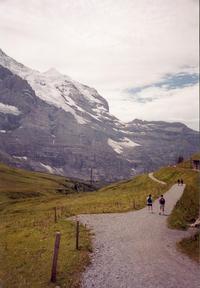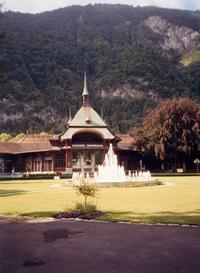Interlaken
 As its name suggests, Interlaken is set between two lakes  Thun and Brienz  in a quintessentially Swiss setting surrounded by the awe-inspiring Jungfrau, Eiger and Mönch mountains. Once the home of an Augustinian monastery, the town is now prized by summer and winter visitors for its geographical position as the gateway to the Bernese Oberland. With excellent rail links, it receives passengers from nearby cities and connects them with the numerous tiny villages of the neighbouring mountains via quaint rack-railways. Many people visit the town on route to a mountain resort; however, many more take advantage of Interlaken as a handy base from which to explore the stunning region.
As its name suggests, Interlaken is set between two lakes  Thun and Brienz  in a quintessentially Swiss setting surrounded by the awe-inspiring Jungfrau, Eiger and Mönch mountains. Once the home of an Augustinian monastery, the town is now prized by summer and winter visitors for its geographical position as the gateway to the Bernese Oberland. With excellent rail links, it receives passengers from nearby cities and connects them with the numerous tiny villages of the neighbouring mountains via quaint rack-railways. Many people visit the town on route to a mountain resort; however, many more take advantage of Interlaken as a handy base from which to explore the stunning region.
Attractions
By far the largest contributor to the economy of the area is the adventure sport industry. During the summer there are countless activities available, including mountain-biking, ice-skating, paragliding, skydiving, white-water rafting, canyoning, kayaking, abseiling, bungee jumping, rock-climbing and ice and glacier treks. During the winter, skiing, snowboarding, snowrafting, glacier skiing and ice canyoning are offered.
For those seeking a less active holiday, many excursions may be taken from Interlaken. Several railways take tourists to the summits of nearby peaks to see the spectacular views: a funicular by Interlaken Ost station goes up the Harderklum, whilst another  situated just south of Interlaken West railway station  travels to the top of the Heimwehfluh. In addition, a rack-railway goes to the Schynige Platte, where hikers can enjoy one of the many walks which lead from the top. But perhaps one of the best trips is that to the Lauterbrunnen Valley. The town of Lauterbrunnen is reached by train from Interlaken Ost station, and from here a mountain railway takes passengers to the villages of Wengen  a most attractive car-free idyll Â, Kleinescheidegg, and ultimately to the [http://www.jungfraubahn.ch/en/DesktopDefault.aspx/tabid-8//183_read-808 Jungfraujoch]. The Jungfraujoch lies between the Mönch and Jungfrau mountains and is a tourist observation and scientific research centre. As well as being famous for having the highest railway station (3,454 metres) in Europe, the complex houses a fascinating ice palace with a vast number of ice sculptures, an exhibition about how the railway was constructed, a restaurant and a tourist shop. It is even possible to venture into the snow for unparalleled views of the surrounding mountains, or perhaps a husky-drawn sled ride.
 Also of interest are the [http://www.beatushoehlen.ch/e/anlage/ St Beatus Caves]. The caves are the former residence of the sixth-century Christian ascetic St Beatus, who lived here as a missionary. On account of the miracles he performed and the subsequent cult which grew around him, the caves have attracted pilgrims from around the world for centuries. Guided tours are now available around the restored caves, which tell the full story of their history.
Also of interest are the [http://www.beatushoehlen.ch/e/anlage/ St Beatus Caves]. The caves are the former residence of the sixth-century Christian ascetic St Beatus, who lived here as a missionary. On account of the miracles he performed and the subsequent cult which grew around him, the caves have attracted pilgrims from around the world for centuries. Guided tours are now available around the restored caves, which tell the full story of their history.
In Interlaken itself, visitors curious about the townÂs past can explore the ruins of the medieval settlement which existed from the twelfth century onwards, or the remains of the fifteenth-century monastic buildings and Gothic church. On the Höhematte  the large grassy parkland on which InterlakenÂs Augustinian monks once grazed their cattle  modern visitors can relax and take in the uplifting views as well as the fantastically fresh air. The formal gardens around the Casino Kursaal too, are a pleasant distraction on a fine day.
Interlaken is also oddly famous throughout Switzerland for its annual staging of SchillerÂs play "William Tell", which has been performed every July and August since 1912, in an open-air theatre in the Rugen Woods near Matten. With a forest as its backdrop and a large cast dressed in traditional Swiss finery, it is a magical and endearing spectacle.
Shopping
There is one main high street  Höheweg  which accommodates a plentiful array of shops, from the touristy to the upmarket. Swiss specialities such as chocolate, cheese, penknives, watches, music boxes, clocks, cowbells and wind chimes are all widely available; there is also a profusion of sports clothes and equipment shops. Regular markets take place throughout the year, and there are special Christmas market stalls in December.
Nightlife and Eating Out
Although cuisines from around the world are well represented in the many restaurants and brasseries of Interlaken, there are a few traditional rustic wood-beamed alehouses serving local fare  such as fondue and raclette  for those after the archetypal Swiss experience.
By night, the townÂs numerous cafés, bars, nightclubs and cabaret bars come alive. For a relaxed evening, InterlakenÂs two cinemas  the [http://www.cineman.ch/kinoprogramm/theatre/detail.php?theatre_id-147 Cine Rex Piccolo] and the [http://www.cineman.ch/kinoprogramm/theatre/detail.php?theatre_id-148 Cine Rex]  show a small selection of the latest releases. On the other hand, the [http://www.casino-interlaken.ch Casino Kursaal] may appeal to more extravagant tastes: within the nineteenth-century building is a functioning casino with roulette and black jack, in addition to a theatre area where guests receive a customary Swiss meal followed by traditional music, dance and folklore.
During the summer however, there can be no surpassing an evening cruise on Lake Brienz. Indulged in fine food and wine whilst gliding across the serene turquoise waters and surrounded by the twinkling lights of the Swiss chalet villages, one could quite fancy being caught up in a dream.
Tourist Information
Höheweg 37CH-3800 Interlaken
- Telephone: +41 (0)33 826 53 00
- Email: mail@interlakentourism.ch
- Website: [http://www.interlaken.ch/index.php?id=53&L=3/ www.interlakentourism.ch]
Airport
Interlaken has excellent rail links to Zurich Airport (2.5 hours), Geneva Airport (3 hours), and  for domestic flights  Bern Airport (1.25 hours).
Popular car hire locations in Switzerland
All car hire locations in Switzerland
- Aarau

- Aigle

- Airolo

- Altendorf

- Appenzell

- Ascona

- Ascona Airport

- Baar

- Bachenbülach

- Basel

- Bellinzona

- Bern

- Bern Belp Airport

- Bex

- Biel

- Biel-Mett

- Brig

- Brügg

- Buchs

- Cham

- Chur

- Crans-Montana

- Crissier

- Davos

- Domat

- Dübendorf

- Düdingen

- Emmen Airport

- Frauenfeld

- Fribourg

- Geneva Cointrin International Airport

- Genève

- Gstaad

- Herzogenbuchsee

- Interlaken

- Jona

- Klosters Platz

- Kriens

- La Chaux-De-Fonds

- Langenthal

- Lausanne

- Locarno

- Lugano

- Lugano Airport

- Luzern

- Martigny

- Mendrisio

- Montreux

- Neuchâtel

- Niederuzwil

- Oberbüren

- Orbe

- Pratteln

- Ried

- Rolle

- Rothrist

- Saint Moritz

- Samaden

- Samedan Airport

- Sankt Gallen

- Schaffhausen

- Schattdorf

- Schinznach Bad

- Sierre

- Sihlbrugg Dorf

- Sion

- Sion Airport

- Solothurn

- St Gallen Altenrhein Airport

- Staad

- Stans

- Stein

- Thun

- Tägerwilen

- Uster

- Verbier

- Vevey

- Weidli

- Winterthur

- Yverdon-Les-Bains

- Zuchwil

- Zug

- Zürich

- Zürich Airport




